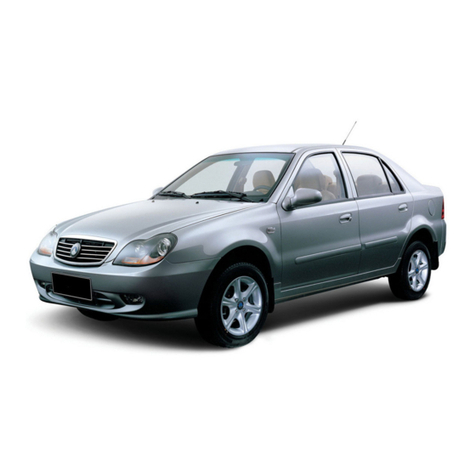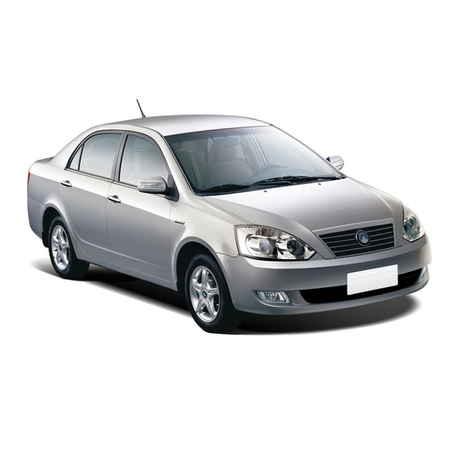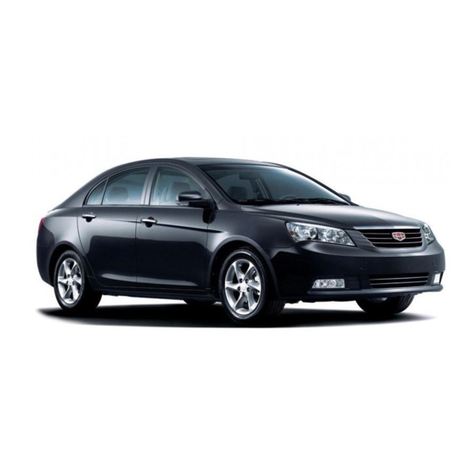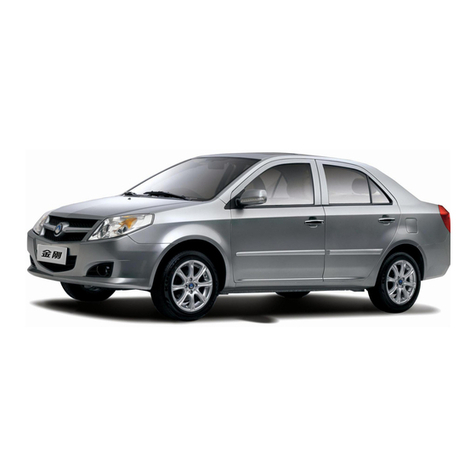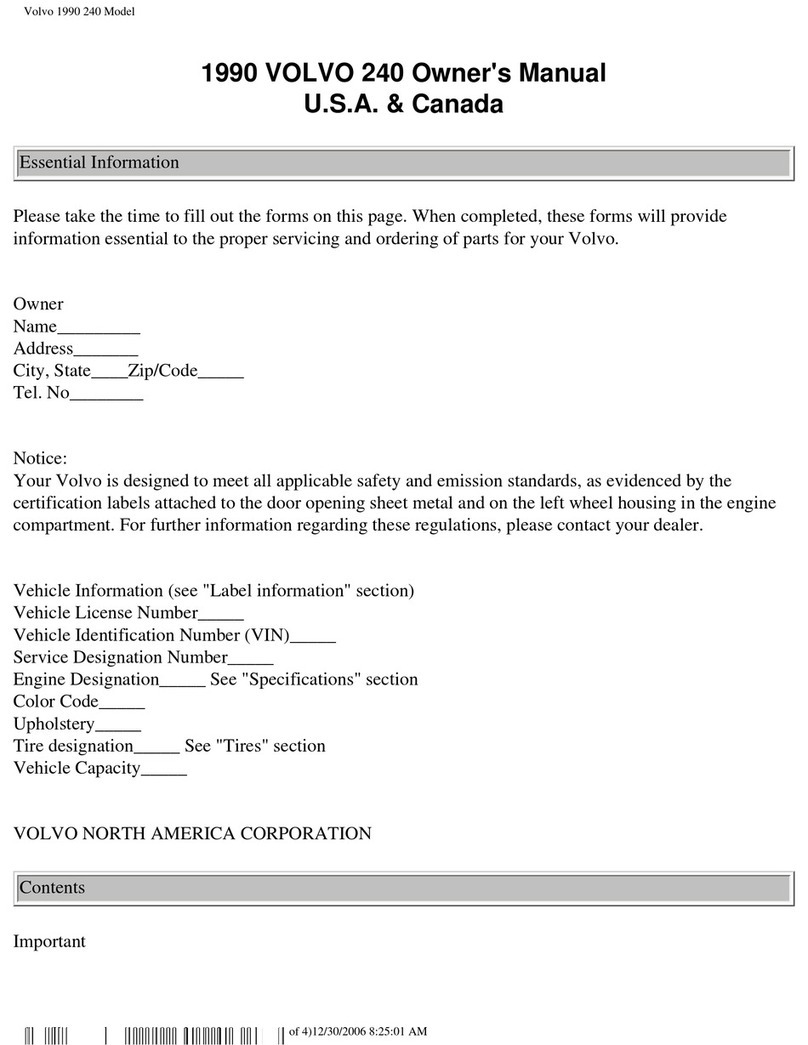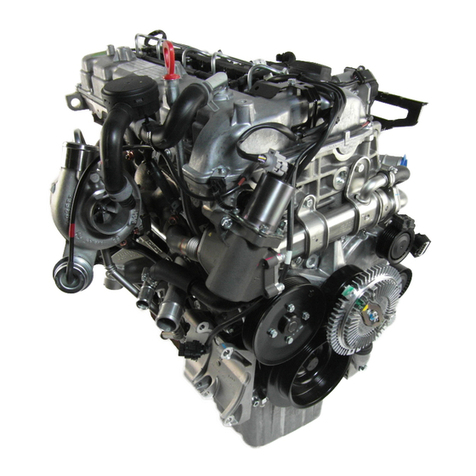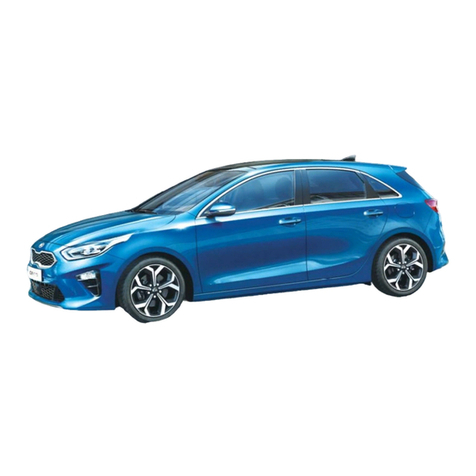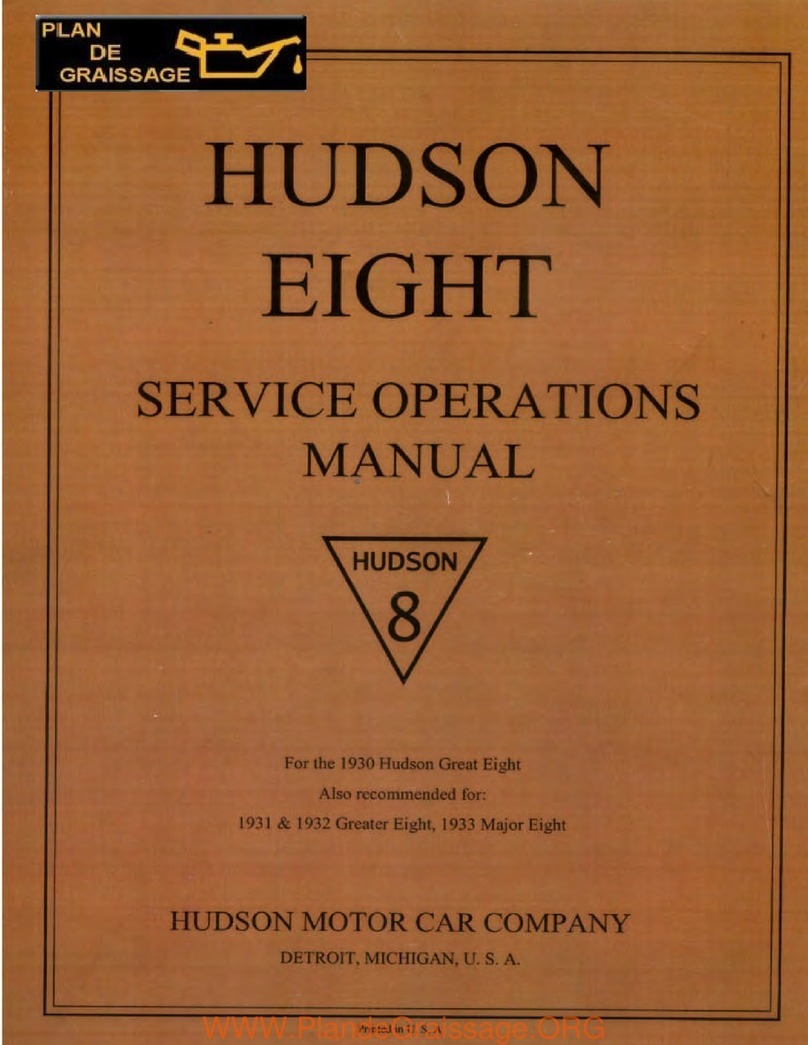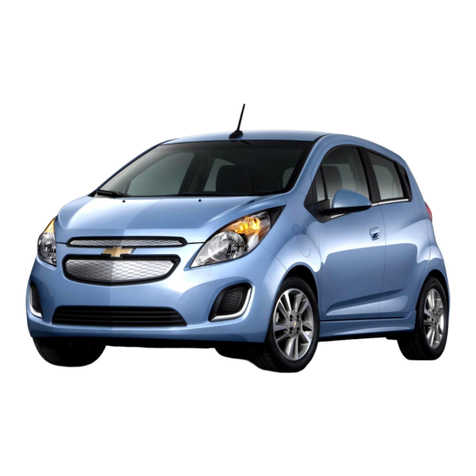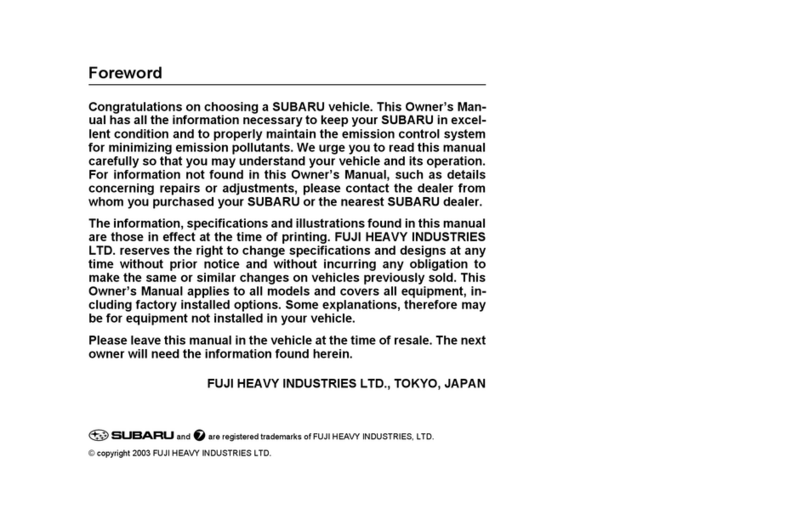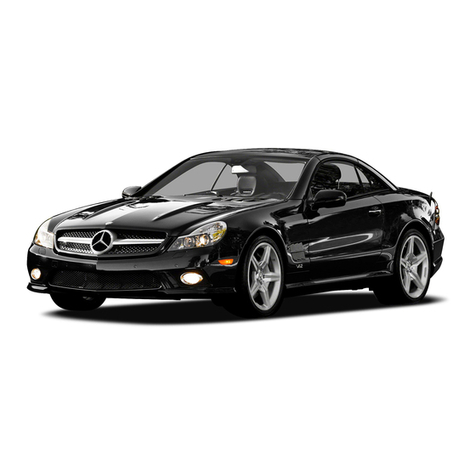Geely Emgrand 2015 User manual

FOREWORD
Dear users:
Thank you for your trust in Geely Automobile and choosing a Geely automobile with
excellent safety, comfort, dynamic and economy performances. We look forward to bring
pleasure to your work and life with high quality products and services.
Read and observe the contents in this manual before you use the vehicle for the first
time. This will help you understand and use Geely automobile better so that your new vehicle
can be kept in the good technical condition in the future use and in the optimum performance
at all times. The more that you know about your vehicle, the greater the safety and pleasure
you will get from driving it.
If you find some problems during use, contact the nearest Geely Automobile Service
Station authorized by our company and they will provide high quality services for you in
terms of maintenance and repair. Please be sure to complete the maintenance tasks regu-
larly according to the maintenance regulations in this manual.
This vehicle provides all information related to this model. Depending on the configura-
tion of the vehicle, the instruction in this manual may differ from the actual configuration of
the vehicle you bought, so you should be subject to the vehicle actually received.
When reselling or lending your vehicle, please hand over this manual to the new owner,
as the manual is a part of the whole vehicle.
All information in this manual is based on the latest product information at the time of
publication and will be subject to change in the future with supplementary notice according to
relative regulations.
Wish you a happy life and good luck!
Geely Automotive
June 2015
All rights reserved. No part of this manual may be reproduced or copied without the written
permission of Geely Automotive.
NOTE: The illustration of the vehicle model on the cover of this manual is for reference only
and the exact condition is subject to the actual vehicle.


1
2
3
4
5
6
7
8
1
Introduction of Owner's
Manual and Vehicle
Identification
5 Introduction of Owner's Manual
5 Notes to Owners
6 Hint
6 Symbols
6 Vehicle Identification
6 Vehicle Identification Marker
7 Location of Vehicle
Identification Marker
Instrument and Control
9 Instrument and Control Device
11 Combination Meter
12 Tachometer
12 Speedometer
13 Information Center
13 Upper Display
14 Overview of Main Display
15 Information of Main Display
17 Warning Light and Indicator
17 Layout of Warning Light and
Indicator
18 Instructions of Warning
Light and Indicator
21 Light and Indicator
21 Light Control Combination
Switch
23 Hazard Warning Light
23 Instrument Panel Switch
Bank Assembly
24 Wipers and Washers
24 Wiper Control Combination
Switch (Sedan)
24 Wiper Control Combination
Switch (Hatchback)
26 Steering Column
26 Adjustment of Steering
Wheel
26 Rear View Mirror
26 Exterior Rear View Mirror
28 Mechanical Anti-glare
Interior Rear View Mirror
28 Sun Visor and Vanity Mirror
29 Horn
29 Window
30 Power Window
31 Sunroof
34 Interior Settings
34 Front Interior Light (w/o
Sunroof)
34 Front Interior Light (w/
Sunroof)
35 Rear Interior Light
35 Cigarette Lighter
36 Center Armrest
37 Rear Window Sunshade
37 Glove Box
38 Storage Box
38 Glasses Box
39 Cup Holder
39 Interior Door Handle
40 Coat Hook
40 Floor Mat
Contents

2
Air Conditioning and
Entertainment System
41 Heating, Ventilation and Air
Conditioning
41 Automatic Air Conditioning
Control System
45 Manual Air Conditioning
Control System
47 Operation Recommendation
48 Air Vent
49 Maintenance of Air
Conditioning System
50 In-vehicle Entertainment System
50 Multimedia Player
56 Intelligent On-board Host/
GPS Host
Seat and Protection
Device
61 Head Restraint
62 Adjustment of Front Seat and
Rear Seat
66 Seat Belt
67 Why Seat Belt Has
Protective Effect
67 Correct Seating Posture
69 How to Wear Seat Belt
Correctly
70 3-Point Type Seat Belt
71 Shoulder Belt Height
Adjuster
72 Seat Belt Pretensioner
72 Fasten Seat Belt Warning
73 Seat Belts and Pregnant
Women
73 Safety System Check
73 Seat Belt Maintenance
74 Replace Components of
Seat Belt System after a
Collision
74 Airbag
75 Locations of Airbags
79 Deployment of Airbags
83 Airbag Warning Light
84 Replace Components of
Airbag System after a
Collision
84 Disposal of Vehicle
84 Child Restraint System
84 Older Children
86 Infants
87 Child Restraint System
88 Installation Position of Child
Safety Device
89 Installation of Child
Protection Device
Starting and Driving
95 Key and Anti-theft System
95 Key
95 Replacement of Batteries of
Remote Control
96 Anti-theft System
96 Engine Anti-theft System
97 Lock and Unlock
101 Starting and Driving
101 Start Switch (Keyless
Starting)
102 Starting Engine
104 Vehicle Failure to Be
Started

1
2
3
4
5
6
7
8
3
105 Driving
107 Three-way Catalytic Converter
107 Fuel Requirements
108 Starting Requirements
108 Driving Requirements
108 Engine Exhaust Emission Alarm
108 Exhaust Emission Control
Device
108 Exhaust Gas from Engine
109 Fuel System
109 Gasoline Requirements
110 Safety Precautions in
Gasoline Station
111 Oil Filler and Charging
Fuel Oil
112 Automatic Transmission (CTV)
112 Gears Information
114 Gear Shifting Operation
115 Manual Transmission (MT)
115 Notices for Use
116 Brake System
116 Service Brake
117 Parking Brake
117 Electronic Stable Control
System (ESC)
118 ABS (Anti-Lock Braking
System)
119 Park Assist System
119 How Does the System
Work?
120 System Operation
122 Rear View Camera*
124 Cruise Control System*
124 Setting Cruise Control
124 Recovery of the Set Speed
125 Accelerating under Cruise
Control
125 Decelerating under Cruise
Control
125 Overtaking under Cruise
Control
125 Using Cruise Control on
Ramp
125 Terminating Cruise Control
125 Eliminating Speed Record
126 Loading
126 Loading Objects
Faults on the Way
127 Hazard Warning Devices
127 Hazard Warning Light
129 Emergency Opening of Trunk
(Sedan)
130 Release Shift Lever (CVT) from
Park (P) Position Manually
131 Drawing Vehicle
131 Hints for Drawing
132 Installation of Front Draw
Ring
132 Replacement of Tire
132 Taking out Spare Tire and
Tools
133 Removal of Flat Tire and
Installation of Spare Tire
135 Storage of Flat Tire or
Spare Tire and Tools
135 Replacement of Fuse
136 Position and Recognition
of Fuse
136 Fuse Box in the Engine
Compartment
139 Central Distribution Box

4
142 Check or Replacement of
Fuse
142 Replacement of Bulb
143 Specifications of Bulb
145 Vehicle Overheating
146 Stalling of Engine/ Ridding Car
Trapped Situation
146 Stalling of Engine
146 Ridding Car Trapped
Situation
Service and Maintenance
147 Maintenance
147 Scheduled Maintenance
149 Engine Hood
149 Opening the Engine Hood
150 Closing the Engine Hood
151 Engine Compartment
151 JLB-4G13T Engine
152 JLγ-4G15 Engine
153 Engine
153 Checking and Adding
Engine Oil
153 Engine Air Cleaner/Filter
Element
155 Cooling System
155 Checking Engine Coolant
156 How to Fill Coolant
Reservoir with Coolant
158 Brake System
159 Brake Pedal Travel
159 Replacement of Brake
System Components
159 Brake Fluid
161 Power Steering
161 Hydraulic Power Steering
161 Front Combination Headlight
161 Fogging up of Front
Combination Headlight
162 Battery
162 Using and Maintenance of
Battery
163 Replacement of Battery
163 Vehicle Storage
164 Washer
164 What Kind of Washer Fluid
to Use
165 Wiper
165 Wiper Blade
165 Replacement of Front
Windshield Wiper Blade
166 Replacement of Rear
Windshield Wiper Blade
(Hatchback)
166 Tire
167 Winter Tire
167 Tire Pressure
168 When to Check the Tires
168 How to Check the Tires
168 Tire Pressure Monitor
System
169 Inspection and Rotation of
Tire
169 When to Use New Tire
170 Purchase New Tires
170 Tires or Wheels of a
Different Size
171 Wheel Alignment and Tire
Balance
171 Replacement of Wheel
171 Using the Used Wheel
172 Tire Chain
172 When Getting a Flat Tire

1
2
3
4
5
6
7
8
5
173 Cleaning and Vehicle
Maintenance
173 Cleaning of Interior
174 Fabric/Floor Carpet
175 Cleaning of Leather
175 Instrument Panel, Vinyl
Resin and Other Plastic
Surfaces
Technical Data
177 Major Dimension Parameter of
Vehicle
179 Gross Vehicle Weight
181 Main Engine Parameters
182 Vehicle Power Performance
183 Vehicle Fuel Economy
184 Emission Level
185 Wheel and Tire
185 Road Tire Model
185 Spare Tire Model
185 Dynamic Imbalance of
Tires
185 Tire Inflation Pressure
(Cold)
186 Wheel Alignment
Parameter (Unloaded)
187 Recommended Oil and
Capacity


1
2
3
4
5
6
7
8
Introduction of Owner's Manual and Vehicle Identification
7
Introduction of Owner's Manual and Vehicle Identification
Introduction of Owner's Manual
Notes to Owners
1. Your vehicle is equipped with the Anti-
lock Brake System (ABS). In the event
of heavy braking, firmly press the brake
pedal and do not pump the brake.
2. Check the wear and pressure of tires
regularly according to the recom-
mended method and tire pressure spec-
ification in the Owner's Manual.
3. Please use the recommended oil and
fluid in the Owner's Manual. Perform
maintenance according to the require-
ments in the Warranty and Maintenance
Manual.
4. Your vehicle is equipped with airbags.
For the children's riding safety, do not
position children on the front seat.
5. For your riding safety, do not remove
any components from the vehicle by
yourself, especially the components of
the chassis. New fasteners may be
coated with seal lock adhesive, so they
are not renewable after removal.
6. Any modifications or adding devices to
the vehicle are not allowed. We will bear
no responsibility for any direct or indi-
rect loss deriving from non-compliance
with the above mentioned warnings.
7. Among fires caused by the overheated
exhaust pipe, a typical case is a fire
caused by the driver who falls asleep in
the vehicle and presses the accelerator
pedal unintentionally. This is due to
overheated exhaust pipe caused by
abnormally high speed or continuous
idling of the engine. Under its influence
of heat conduction and radiation, the O-
ring attached to the exhaust pipe or the
floor in the vehicle may catch fire. Driver
sleeping in the vehicle is generally due
to excessive drinking and inability to go
home or sleeping in the vehicle with the
A/C on. Therefore, this will threaten the
life safety of persons in the vehicle in
the event of fire.

Introduction of Owner's Manual and Vehicle Identification
8
Prompt Message
WARNING
Failure to follow the warning could
result in a collision or bodily injury.
You must strictly follow the procedures
described or carefully review the provided
information.
CAUTION
It is against procedures that could
result in damage to your vehicle.
ENVIRONMENTAL PROTECTION
It defines the correct driving behavior
to protect the environment.
NOTE
Note: suggestive statement, for you to
better use the vehicle information.
ASTERISK
The asterisk “*” following the title or name
indicates that the described device or func-
tion is provided only for certain models and
may not provided for the vehicle you
bought.
Illustration Symbols
Indicate the described objects.
Indicate the moving directions of the
objects.
Indicate not to do this or let this hap-
pen.
Vehicle Identification
Vehicle Identification Marker
When you contact the Geely Automobile
Service Station, the vehicle identification
number (VIN) should be provided.
When you communicate with the Geely
Automobile Service Station about the
engine, the number of the engine assembly
may also need to be provided.
1. Vehicle Identification Number (VIN)
2. Engine Number

1
2
3
4
5
6
7
8
Introduction of Owner's Manual and Vehicle Identification
9
Location of Vehicle Identification
Marker
Location of Vehicle Identification
Number (VIN)
There are three positions marked with vehi-
cle identification numbers on your vehicle.
•On the plate located on the left front cor-
ner of the instrument panel pad, visible
from outside of the vehicle through the
windshield.
•On the cowl panel in the engine com-
partment. If the VIN stamped on the
vehicle body is worn, contact the Geely
Automobile Service Station immedi-
ately.
•On the vehicle plate.
The Vehicle Identification Number (VIN)
consists of 17 characters. It includes the
manufacturer, model year, body type and
number, engine number and assembly
plant of the vehicle.
Location of Engine Number
The engine number (JLγ-4G15, JLC-4G18,
JLC-4M15 and JLC-4M18) is stamped on
the engine body, near the transmission
(view from the front of the vehicle).
There are two locations of the engine num-
ber for JLB-4G13T engine:
•Stamped on the engine body, near the
transmission.
•Stamped on the timing chain cover of
the side of the engine (view from the RH
side of the vehicle).
tion

Introduction of Owner's Manual and Vehicle Identification
10
Vehicle Plate
The vehicle plate is below the RH B-pillar,
and contains the following information:
•Company name
•Vehicle identification number
•Brand
•Model
•Engine type
•Seating capacity
•Engine rated power
•Engine displacement
•Maximum design mass
•Manufacturing date

1
2
3
4
5
6
7
8
Instrument and Controls
11
Instrume nt and Contro ls
Instrument and Control Device
1. Passenger window lock switch
2. Interior lock button
3. Interior door handle
4. Air outlet LH
5. Defroster air outlet LH
6. Security indicator
7. Light control switch
8. Instrument cluster
9. Steering wheel button
10. Headlight leveling adjustment switch
11. Hood release lever
12. Liftgate / trunk lid switch
13. Dimmer control knob
14. Power mirror select button
15. Power mirror adjustment switch
16. Power window control switch

Instrument and Controls
12
Export Edition
1. Rear window lock switch
2. Interior door lock button
3. Interior door handle
4. Air outlet LH
5. Defroster air outlet LH
6. Security indicator
7. Windshield defroster switch
8. Light control switch
9. Instrument cluster
10. Steering wheel button
11. Headlight leveling adjustment switch
12. Hood release lever
13. Liftgate / trunk lid switch
14. SOSfull frequency speaker* / storage
compartment
15. Dimmer control knob
16. Power mirror select button
17. Power mirror adjustment switch
18. Power window control switch

1
2
3
4
5
6
7
8
Instrument and Controls
13
1. Wiper control switch
2. Hazard warning light switch
3. Center air outlet
4. Audio control panel
5. Glove box door handle
6. Glove box
7. Defroster air outlet RH
8. Air outlet RH
9. Interior door handle
10. Interior door lock button
11. Power window control switch
12. Parking brake lever
13. Transmission shift lever
14. Cigarette lighter / ashtray
15. A/C control panel
16. Keyless ignition switch

Instrument and Controls
14
Instrument Cluster
1. Tachometer
2. Upper display
3. Speedometer
4. Main display
Dist.To Empty
Instant Fuel
--.-- L/h
--- Km

1
2
3
4
5
6
7
8
Instrument and Controls
15
Instrument Cluster (for Methanol Application)
1. Tachometer
2. Temperature gauge
3. Speedometer
4. Main display
Methanol Gasoline
Methanol

Instrument and Controls
16
Tachometer
The tachometer indicates the engine speed in
1,000 rpm per minute and the maximum dis-
play scale is 8,000 rpm.
During driving, you can use the tachometer
to select proper shift timing in order to avoid
excessive engine load or speed.
If the engine speed is too high during driv-
ing, the engine tends to be worn and the
fuel consumption may increase. Usually,
fuel consumption stays low when the
engine speed is slow.
The pointer of the tachometer may move to
the bottom when the engine is started. This
is not a malfunction.
Do not let the pointer of the engine
tachometer reach the red zone, which
can cause serious damage to the engine.
Speedometer
The speedometer indicates the current
vehicle speed (km/h) and the maximum
scale is 240 km/h.
You can drive at high speed on the roads in
good condition. However, the vehicle speed
should not exceed 120 km/h on the general
roads for safety, stability and comfort while
driving.

1
2
3
4
5
6
7
8
Instrument and Controls
17
Information Center
Upper Display
Fuel Gauge
The fuel gauge indicates the actual amount
of the remaining fuel in the fuel tank with 8
pointers of the same length. When the cur-
rent fuel level falls in one zone, the appro-
priate LED pointer will be illuminated.
Near FULL fuel tank – The rightmost pointer
illuminates.
Near EMPTY fuel tank – The leftmost pointer
illuminates.
It is preferable to keep the remaining fuel in
the fuel tank over 1/4 of the fuel tank capac-
ity. If the pointer of the fuel gauge is in the
red zone or the low fuel indicator illuminates,
fill fuel immediately. The indicator will go off
automatically after filling and driving for a
while. If not, have the vehicle inspected by
Geely Service Station immediately.
Driving the vehicle with low fuel level
continuously tends to cause prema-
ture damage to the fuel pump.
When driving the vehicle with low fuel level
continuously, stalled engine may cause
damage to catalytic converter.
Temperature Gauge (for methanol
application)
The temperature gauge shows engine cool-
ant temperature, when the ignition switch is
turned ON. During normal driving, four
pointers should illuminate.
The operating temperature of the engine
may change greatly depending on the air
temperature and engine load.
If the pointer of the temperature gauge
approaches the red zone or higher, stop the
vehicle to let the engine cool down.
Under extremely driving conditions, the
engine may be overheating, such as:
•Drive uphill for long distance in the hot
weather.
•Decelerate or stop the vehicle after driv-
ing at high speeds.
•In heavy traffic, use the air conditioning
system and idle the engine for a long
time.
•When towing a vehicle.

Instrument and Controls
18
Overview of Main Display
The instrument cluster is equipped a 3.5-inch liquid crystal display (LCD) to indicate driving
information, such as accumulated mileage, trip mileage, distance to empty, door ajar warn-
ing, transmission range, textual warning, etc.
1. Textual message
2. Distance to empty, dynamical fuel econ-
omy
3. Temperature gauge
4. 4-door ajar and rear park assist displays
5. Accumulated mileage and trip mileage
displays
Note: the unit for dynamical fuel economy display is L/h whe n t h e e n g i n e i s r u n n i n g a t
idle, and the unit is L/100km, when the vehicle is running (see above picture.).
Dist.To Empty
Instant Fuel
--.-- L/h
--- Km
This manual suits for next models
4
Table of contents
Other Geely Automobile manuals
